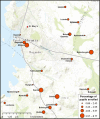Facial shape manifestations of growth faltering in Tanzanian children
- PMID: 29193055
- PMCID: PMC5770324
- DOI: 10.1111/joa.12748
Facial shape manifestations of growth faltering in Tanzanian children
Abstract
Variation in the shape of the human face and in stature is determined by complex interactions between genetic and environmental influences. One such environmental influence is malnourishment, which can result in growth faltering, usually diagnosed by means of comparing an individual's stature with a set of age-appropriate standards. These standards for stature, however, are typically ascertained in groups where people are at low risk for growth faltering. Moreover, genetic differences among populations with respect to stature are well established, further complicating the generalizability of stature-based diagnostic tools. In a large sample of children aged 5-19 years, we obtained high-resolution genomic data, anthropometric measures and 3D facial images from individuals within and around the city of Mwanza, Tanzania. With genome-wide complex trait analysis, we partitioned genetic and environmental variance for growth outcomes and facial shape. We found that children with growth faltering have faces that look like those of older and taller children, in a direction opposite to the expected allometric trajectory, and in ways predicted by the environmental portion of covariance at the community and individual levels. The environmental variance for facial shape varied subtly but significantly among communities, whereas genetic differences were minimal. These results reveal that facial shape preserves information about exposure to undernourishment, with important implications for refining assessments of nutritional status in children and the developmental-genetics of craniofacial variation alike.
Keywords: childhood growth; complex traits; craniofacial; facial imaging; growth faltering.
© 2017 Anatomical Society.
Figures









References
-
- Adams DC, Collyer ML, Otarola‐Castillo E, et al. (2014). Geomorph: Software for Geometric Morphometric Analyses. R package version 2.1. http://cran.r-project.org/web/packages/geomorph/index.html
-
- Baker J, Workman M, Bedrick E, et al. (2010) Brains versus brawn: an empirical test of Barker's brain sparing model. Am J Human Biol 22, 206–215. - PubMed
-
- Beegle K, De Weerdt J, Dercon S (2011) Migration and economic mobility in Tanzania: evidence from a tracking survey. Rev Econ Stat 93, 1010–1033.
-
- Black RE, Victora CG, Walker SP, et al. (2013) Maternal and child undernutrition and overweight in low‐income and middle‐income countries. Lancet 382, 427–451. - PubMed
Publication types
MeSH terms
Grants and funding
LinkOut - more resources
Full Text Sources
Other Literature Sources
Medical

